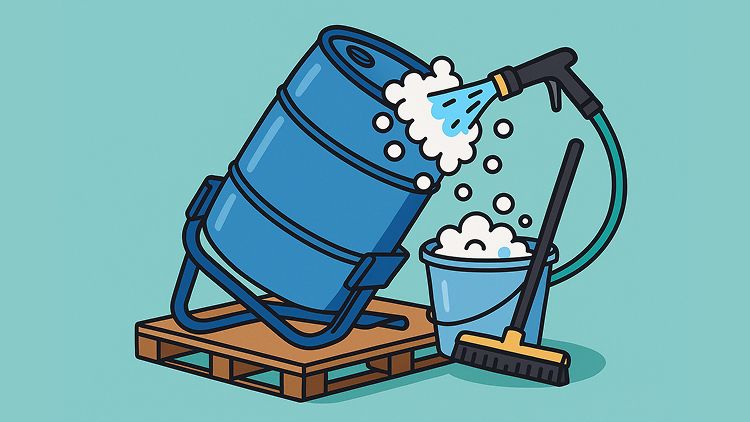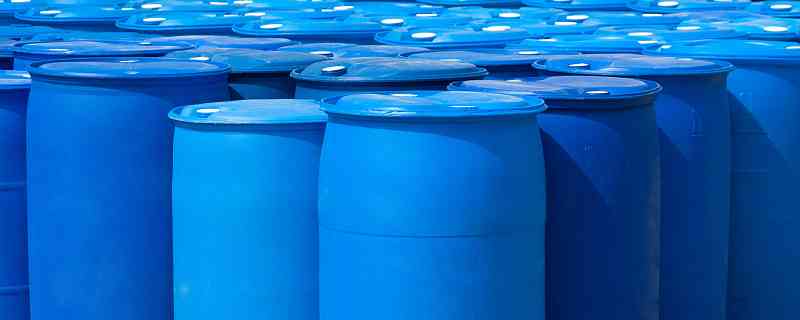How to Clean Chemicals Out of Plastic Barrels
Safe, simple steps to decontaminate HDPE barrels (tight-head and open-head), what to use, what to avoid, and when to call a pro.

Key takeaways:
- Identify the previous contents and follow the SDS before you choose a cleaner; never mix incompatible chemicals.
- Use a step-by-step process: empty → PPE → contain → wash → neutralize (if needed) → rinse → dry → inspect.
- For hazardous residues or barrels meant for potable water, be stricter: consider professional reconditioning or dedicated food-grade barrels.
FAQs
How to clean chemicals out of plastic barrels without damaging them?
Use cleaners compatible with HDPE: neutral detergents and common alkaline degreasers are generally safe. Avoid harsh solvents. Test first, keep contact times short, and rinse well.
Can CLR be used on plastic barrels?
Sometimes—for mineral scale on HDPE. Test a small spot first, follow the label, rinse thoroughly, and never mix with bleach. It won’t remove oils or solvent residues.
Can you use Lime Away on plastic?
Similar to CLR: limited use for hard-water scale on HDPE with a small-area test and quick contact. Rinse to neutral. Don’t use Lime-A-Way for petroleum or paint residues.
Is bleach safe on plastic drums?
Short answer: Yes—diluted, unscented household bleach (5–9% sodium hypochlorite) is generally safe for HDPE plastic drums for short contact times.
What cleaner should I use to clean a 55-gallon plastic drum?
Match the cleaner to the residue:
- Water-based residue: mild detergent + warm water
- Oils/grease: alkaline degreaser (pH ~10–12)
- Mineral scale: mild acidic descaler (test on HDPE first)
- Adhesives/paints: specialty remover per the SDS
Never mix chemicals (e.g., bleach with acids/ammonia), and collect/rinse to neutral pH.
Before you get started
If you’re searching how to clean chemicals out of plastic barrels, lock in these basics first:
- Confirm prior contents (from the label/SDS). Classify as water-based, oils/solvents, acids/bases, adhesives/paints, or mineral scale.
- Identify the barrel style. Tight-head (bunged; clean with wand/spray) vs. open-head (removable lid; brush/scrub).
- Set the end use. Non-potable/process use vs. stricter standards for water storage (food-grade only, sanitize after rinsing).
- Use PPE & ventilation. Gloves, eye/face protection, sleeves; respirator if SDS says so; work in a ventilated, controlled area.
- Handle rinsate correctly. Capture, label, keep streams separate, avoid mixing incompatible chemicals, and follow local disposal rules.

How to identify your barrel and residue
Correct ID prevents damage and bad reactions.
- Barrel type
- Tight-head (closed-top): two bungs; access with pumps or a spray wand.
- Open-head (removable-top): lever-lock or bolt ring; full opening for scrubbing.
- Residue type
- Water-based cleaners/detergents: usually respond to warm water + mild detergent.
- Oils/grease: use an alkaline degreaser; finish with a compatible rinse.
- Solvents/paints/adhesives: may need a specialty cleaner; test first.
- Acids/bases: neutralize carefully; never add water to acid.
- Mineral scale (hard water): may respond to mild acid descalers (see CLR/Lime-A-Way notes below).

Match the method to the residue
| Residue Type | Method |
|---|---|
| Water-based detergents, cleaners, food syrups | warm water + surfactant; minimal contact time; rinse until clear |
| Oils/grease/cutting fluids | alkaline degreaser (pH 10–12) + warm rinse; if needed, a final light solvent rinse (DGR/citrus) with proper ventilation |
| Latex paint/adhesives | warm alkaline wash + mechanical brushing; follow with compatible solvent spot-treatment only if the SDS allows |
| Acids/bases | triple-rinse, then neutralize in a controlled container; verify neutral pH before sewer discharge or disposal (if permitted) |
| Strong oxidizers (e.g., hypochlorite, peroxide) | avoid organics/solvents; rinse with large volumes of water; store rinsate separately |
How to clean chemicals out of plastic barrels (step-by-step)
This section gives the general process that works for most HDPE barrels. Match the cleaner to the residue, and scale up only after a small test.
1) Empty and capture
- Drain as completely as possible.
- For viscous contents, let the barrel sit bung-down to “triple-drain.”
2) Pre-rinse (warm)
- Add a few liters of warm water, close the openings, and roll the barrel for 1–2 minutes.
- Drain into a labeled container.
3) Choose the wash method
- Water-based residues: warm water + dish soap or neutral detergent.
- Oils/grease: alkaline degreaser (pH ~10–12) per product directions.
- Adhesives/paints: warm alkaline wash + mechanical agitation; spot-treat with a compatible solvent only if the SDS allows.
- Acids/bases: neutralize in a controlled container; then wash.
4) Apply, agitate, contact time
- Tight-head: use a wand or rotary spray head through the 2″ bung.
- Open-head: scrub walls and bottom with a long-handle brush.
- Keep contact times short at first (5–10 minutes), then extend if needed.
5) Rinse thoroughly
- Rinse warm, then cool.
- Repeat until the rinse is clear and (if relevant) pH is neutral.
6) Optional: targeted second step
- For stubborn oils, do a brief compatible solvent rinse. Ground/bond if flammable and capture all rinsate.
7) Dry and inspect
- Invert on a rack or use filtered air (low heat).
- Check for cracks, bulges, brittle plastic, damaged rings/gaskets, and lingering odor. Replace worn bung caps and gaskets.

Can CLR or Lime-A-Way be used on plastic?
Short answer: sometimes, for mineral scale—but be careful.
- What they’re for: CLR and Lime-A-Way are acidic descalers designed to remove calcium, lime, and rust.
- On HDPE: HDPE generally tolerates short contact with mild acids, but always test a small area first.
- Limits: These products won’t remove oils, solvents, or paint residues. They’re for hard-water scale, not heavy contamination.
- Never mix: Do not combine acidic descalers with bleach or ammonia.
- Rinse well: After any acidic product, rinse thoroughly and verify neutral pH.
How to clean plastic barrels for water storage
If you want a barrel for water, raise the bar on cleanliness.
- Know the history: If the barrel ever held hazardous chemicals, do not use it for potable water.
- Prefer food-grade: Start with a barrel that’s food-grade HDPE and has a clean history (CDC guidance on cleaning & sanitizing water containers).
- Use mild cleaners: Warm water + a mild, fragrance-free detergent. Avoid strong solvents.
- Sanitize last: After washing and clear rinses, sanitize with a proper solution (e.g., a small amount of unscented household bleach diluted per public health guidance). Do not mix bleach with acids or vinegar.
- Final rinses: Rinse until there’s no odor. Let it air-dry completely before filling.

What not to do
- Don’t mix cleaners (e.g., bleach + acid or bleach + ammonia).
- Don’t use abrasives that gouge HDPE.
- Don’t use barrels with structural damage (deep dents, cracks, brittle plastic).
- Don’t assume “food-grade” without documentation if the end use is potable water.
Conclusion
Cleaning used plastic barrels safely is about matching the cleaner to the residue, using a repeatable process, and respecting compatibility and safety rules. For potable water, start with food-grade barrels and follow a cautious sanitize-and-rinse routine. If residues are hazardous or stubborn, professional reconditioning is the safer choice.
Sources
- RCRA “empty container” rule — 40 CFR §261.7 (eCFR): https://www.ecfr.gov/current/title-40/chapter-I/subchapter-I/part-261/subpart-A/section-261.7
- RCRA “empty container” rule (Cornell LII): https://www.law.cornell.edu/cfr/text/40/261.7
- OSHA PPE — 29 CFR 1910.132: https://www.osha.gov/laws-regs/regulations/standardnumber/1910/1910.132
- DOT closure instructions — 49 CFR 178.2(c): https://www.ecfr.gov/current/title-49/part-178/section-178.2
- CDC — Safe water storage (cleaning & sanitizing): https://www.cdc.gov/global-water-sanitation-hygiene/about/about-safe-water-storage.html
- CDC — Emergency water supply (bleach %, container tips): https://www.cdc.gov/water-emergency/about/how-to-create-and-store-an-emergency-water-supply.html
- U.S. Plastic — Chemical Resistance Chart (HDPE): https://www.usplastic.com/knowledgebase/article.aspx?contentkey=825
- U.S. Plastic — Chemical Resistance PDF: https://www.usplastic.com/catalog/files/charts/LG%20CC.pdf
- Cole-Parmer — Chemical Compatibility Database: https://www.coleparmer.com/Chemical-Resistance
- CLR — SDS (Calcium, Lime & Rust Remover): https://www.clrbrands.com/proline/sds
- CLR PRO — FAQs: https://www.clrbrands.com/proline/how-to/faqs
- Lime-A-Way — SDS (example): https://assets.pim.ecolab.com/media/Original/10086/US-Z8-917352-LIME-A-WAY%20%28917352%29.pdf
- Open-head vs tight-head overview (ITP Packaging): https://itppackaging.com/what-is-the-difference-between-an-open-head-and-tight-head-plastic-drum
- Open-head vs tight-head overview (Basco): https://bascousa.com/blog/difference-between-plastic-open-head-drums-and-plastic-tight-head-drums
- Bung thread examples (NPT/NPS + buttress) — Yankee Containers: https://www.yankeecontainers.com/55-gallon-open-head-and-tight-head-blue-industrial-plastic-drums/

